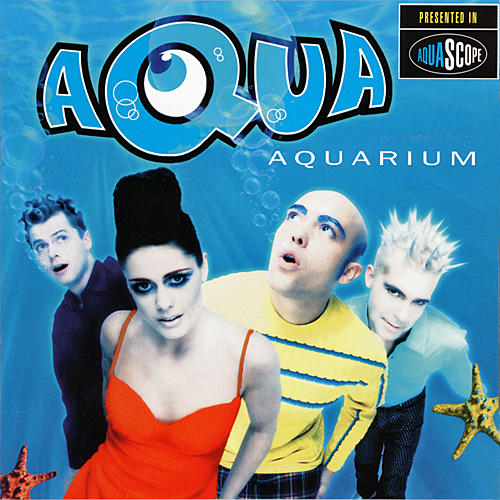 Aquarium — also known as “the album your little sister used to listen to” — makes no attempt at disguising what it is. It’s not varied, or subtle, or smart. It grabs hold of a single working formula (fun danceable bubblegum pop) and spends forty minutes mugging it in a dark alley.
Aquarium — also known as “the album your little sister used to listen to” — makes no attempt at disguising what it is. It’s not varied, or subtle, or smart. It grabs hold of a single working formula (fun danceable bubblegum pop) and spends forty minutes mugging it in a dark alley.
The songs are simple but very tightly constructed, with production as light and airy as spongecake. Lene Nystrøm’s voice has a strange but not unpleasant tonality to it, her voice sounds like that of a talented singing alien. Male vocalist René Dif exists mostly as a foil to Nystrøm’s voice. He could never carry a song on his own, but his back-and-forth exchanges with the female vocals are fun and energetic.
Aqua songs are very catchy. The melodies have a tendency of entering your head and kind of barricading themselves in there, Rorke’s Drift style — armies of Zulus may be needed to dislodge them. “Barbie Girl” is the most famous track (Blender or someone referred to it as “Scandi-Wegian pedo pop”) but “Doctor Jones” and “My Oh My” are also very good. “Be a Man” is boring, but “Turn Back Time” brings the album to a new level of class (ie, any level of class). You’d be ashamed to listen to the rest of this album in mixed company, but “Turn Back Time” sounds mature and sophisticated.
For the most part, the album is full of childish nursery-rhyme lyrics are both adorable and entertainingly creepy. There’s a fair few double-entendres here and there, no doubt an adult could fit his or her own experiences to the words.
Still, the album was clearly written with a particular age range in mind. “Heat of the Night” has Rene Dif confiding “the tequila is here” in an aren’t-I-scandalous voice. So, he brought tequila. I wonder what else he brought that we can’t tell mom and dad about. Alcoholic chocolates shaped like hearts? Stripped by Christina Aguilera…the UNCENSORED version? Plainly, shit is about to go down.
Aquarium is very embarrassing but I think it survives better today than Drake or Pitbull’s albums will in 15 years. It’s catchy, and relatively free of annoying 90s gimmicks. If you want the manly version of this album, acquire I Get Wet by Andrew WK, which is 95% the same but has loud guitars.
No Comments »
 They say nobody should write books about war. The ones who weren’t there will never understand, and the ones who were there remember everything with the most brilliant hindsight a man can have.
They say nobody should write books about war. The ones who weren’t there will never understand, and the ones who were there remember everything with the most brilliant hindsight a man can have.
Tigers in the Mud is the combat memoirs of German tank commander Otto Carius. Rejected twice from the Wehrmacht for being underweight, Carius rose to become one of the most deadly men of World War II, credited with over 150 tank kills. He was awarded the Knight’s Cross, to which Himmler would affix the Oak Leaves in 1944. He served on multiple fronts, fighting “Ivan” in the east and then American soldiers crossing the Rhine. This is his story: WWII from behind the 88mm cannon of a Tiger.
Carius describes the legendary Tiger I with something like awe and something like love. They were the German answer to the Russian T34, huge, ugly, but not without some inner grace. Controlling them was easy (“It drove just like a car”, Carius says), and they could make 45kph on a road and 20kph cross-country. They packed massive firepower. Carius describes stunts such as letting an enemy hide behind a house, and then shooting them straight through the house’s walls.
It’s not all about tanks, it’s also about people, and Carius acclaims the men he fought beside (and under). He seems eager to emphasise the patriotism and camaraderie of the Wehrmacht at the front line, and says that nobody was forced into battle. Some men were Nazis, some opponents of Nazis, some motivated by nothing more political than the glory of their homeland.
Some parts are nail-biting, like when a stiff-necked Oberst orders Carius to advance into a deathtrap. Carius ends up shot once in the forearm, four times in the back, and once in the neck at point blank range.
Some parts are downright bizarre. It seems German administration was lax at writing documentation for the Tiger I. The Russians, however, published excellent guides on the Tiger I’s strengths and weaknesses. The result was a surreal process where German tank drivers had to learn about their own tanks using captured enemy literature.
Carius tells in detail of his meeting with Heinrich Himmler, who is described as calm and friendly. Himmler offers Carius a place in the Waffen-SS, which he declines. Then, in another bizarre scene, Himmler asks if Carius has seen the sights of the city, and gives him a car to go joyriding through Salzberg. The war is winding down at this point, and soon Carius tells of less happy things: the grim conditions of American prison camps where, he says, the Yankees set about proving that they were worse than the Germans. A quote stands out: “peace is hell.”
Carius was a gifted soldier but only an average writer, which is better than the alternative. Had he been a gifted writer but an average soldier he likely would have been killed, which poses great difficulties if you want to write a book.
Nevertheless, I wish there was more detail, and more elaboration. There are many amazing things in this book, but alas, we see them only as sketches. One example is found in the book’s early pages. Carius describes a tank tipping over while falling off a ramp. What happened next? How do you get a sixty ton tank back upright? Who’s job was that in the army? How badly damaged was the tank? I wish he had gone a bit deeper into some things. Tigers in the Mud is a fascinating tour through WWII, but it is a rushed one, and gunsmoke sometimes obscures the view.
No Comments »
 Otep describe themselves as an “artcore collective,” I think that says it all.
Otep describe themselves as an “artcore collective,” I think that says it all.
It is difficult to talk about this band without becoming sarcastic. I heard some songs on 2009’s Smash the Control Machine, which struck me as activism-obsessed liberal mallcore, heavily influenced by Slipknot and Hed(pe), with an annoying female vocalist. But it was music. When you pressed play, loud noise boomed around the place.
When you press play on this, the only loud noise booming around the place is the sound of your uncontrollable laughter. Hydra is practically a spoken word album. It’s 70 minutes long, with at least 50 of those minutes being angsty mutterings, ambient noise, or silence. What a retarded idea. Who the fuck wants to listen to this?
Finding good songs on STCM required a bit of dumpster diving. On Hydra there are very few songs at all, let alone good ones, so all you can do is enjoy the occasional inspired moment. “Hag” has these Nile-sounding blastbeats. “Blowtorch Nightlight” gets really uptempo and fun in the last 40 seconds. Other tracks like “Seduce and Destroy” have heavy guitars but are just utterly boring and limp along like Captain Ahab and Professor X in a three-legged race.
The rest of the album is just a book on tape with a few fragments of metal riffs and keyboard melodies. Otep Shamaya’s voice is the only consistent factor: it is consistently annoying. Whisper… BLAAARGGHHHHH… whiiiiiine…
In general I’m wary of bands with political or socially conscious lyrics, no matter what those lyrics are. When you have (hypothetically) catchy, entertaining music, write lyrics about Iraq, and fill a thundering stadium with fans…are so you deluded to think that your political views are the reason they bought tickets? Do you think that you’re now the leader of a social movement? Henry Rollins is the classic example of a guy crossing his urine streams in such a way. He keeps trying to reinvent himself as some kind of poet/activist, when all anybody truly cares about is a punk rock album he made thirty years ago.
Otep is a bit behind the eightball (they haven’t made a great album yet) but the principle is the same. In general, the bands that become famous for political lyrics do so because of novelty, not because the lyrics themselves are that compelling. In an ocean of brainless Ramones soundalikes, The Clash’s lyrics stood out. In an ocean of brainless speed metal bands, Metallica’s lyrics stood out. If The Clash or Metallica had submitted their political views to an op-ed piece, they would have sunk without a trace. Even in “seen it all” 2013, it’s not ridiculously common for metal bands to address political issues (I’m talking about actual, in-depth commentary, not “fuck the system!” or “support the troops!”), and when you’ve got a female vegetarian lesbian as the singer of your band, then you have more novelty value than most. But that’s all it is: novelty. If you’re a metal band famous for political lyrics, it’s not your brilliant opinions people are noticing. They notice you because you are like a dog that has learned to walk on its hind legs.
The long-ass closing track “Theophagy” just goes on and on forever, repeating itself like a broken record. Recurrent lyric: “I will rise like a Hydra / from the ash.” I assume she’s talking about a phoenix. The Hydra doesn’t rise from the ash. Fire is how you kill it (or at least Hercules did), so ash is the last place you’d expect a Hydra to rise from. And “Hydra” is a proper noun. It refers to a specific, singular monster. Saying “I will rise like a Hydra” is like saying “I will bike through France with a needle in my butt like a Lance Armstrong.”
If you like this band, get a life.
No Comments »
 Aquarium — also known as “the album your little sister used to listen to” — makes no attempt at disguising what it is. It’s not varied, or subtle, or smart. It grabs hold of a single working formula (fun danceable bubblegum pop) and spends forty minutes mugging it in a dark alley.
Aquarium — also known as “the album your little sister used to listen to” — makes no attempt at disguising what it is. It’s not varied, or subtle, or smart. It grabs hold of a single working formula (fun danceable bubblegum pop) and spends forty minutes mugging it in a dark alley.

